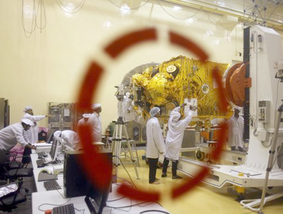
NEW DELHI: India and the U.S. have set up an ISRO-NASA joint working group to explore the possibility of enhancing cooperation for the study of Mars, the government said on December 3. Jitendra Singh, the Minister of State for the Department of Space, said that Indian Space Research Organisation (ISRO) and NASA, respectively, the space agencies of India and the USA, are working together to realise a Dual-Frequency...

Synthetic Aperture Radar mission for Earth observation. India recently launched its Mars Orbiter Mission (MOM) -- Mangalyaan -- while USA's National Aeronautics and Space Administration (NASA) sent its own MAVEN probe to the planet. "The two agencies have established an 'ISRO-NASA Mars Working Group' to explore the possibility of enhancing cooperation in Mars exploration," Singh said in a written response in Lok Sabha. Singh also said ISRO is pursuing international cooperation on the peaceful uses of outer space and that cooperative agreements had been signed with 35 countries. "The areas of cooperation include Remote Sensing of Earth, Satellite Communication, Launch Services, Telemetry and Tracking Support, Space Exploration, Space Law and Capacity Building," he said. The minister said India is also cooperating with China on space with an MoU having been signed with the country in June this year although no agreement is in place between the two.
"India has not signed any agreement with China to develop remote-sensing satellites for disaster management and preparedness. "However, an MoU has been signed with China National Space Agency on cooperation," the minister said. Singh added that with Canada, ISRO is working on an Ultra Violet Imaging Telescope (UVIT) to be accommodated in India's ASTROSAT satellite. The minister said that in the next three years, ISRO intends to launch a multi-wavelength astronomy satellite -- ASTROSAT -- for studying the celestial sources over a wide spectral region covering Visible, Ultraviolet, Soft X-rays and Hard X-ray bands as also the Chandrayaan-2. "The Chandrayaan-2 mission will comprise an Indian Orbiter, Lander and Rover. The Orbiter with scientific payloads will orbit around the moon. The scientific payloads on board the Orbiter, Lander and Rover are expected to perform mineralogical and elemental studies of the lunar surface," Singh said.
He added that a scientific mission -- 'Aditya' -- to understand the physical processes that heat up the solar corona would be soon launched. India had on Sept. 24 created space history by successfully placing its low-cost Mars spacecraft in orbit around the Red Planet in its very first attempt. India's Mars mission is the cheapest inter-planetary mission, costing a 10th of NASA's MAVEN.
"India has not signed any agreement with China to develop remote-sensing satellites for disaster management and preparedness. "However, an MoU has been signed with China National Space Agency on cooperation," the minister said. Singh added that with Canada, ISRO is working on an Ultra Violet Imaging Telescope (UVIT) to be accommodated in India's ASTROSAT satellite. The minister said that in the next three years, ISRO intends to launch a multi-wavelength astronomy satellite -- ASTROSAT -- for studying the celestial sources over a wide spectral region covering Visible, Ultraviolet, Soft X-rays and Hard X-ray bands as also the Chandrayaan-2. "The Chandrayaan-2 mission will comprise an Indian Orbiter, Lander and Rover. The Orbiter with scientific payloads will orbit around the moon. The scientific payloads on board the Orbiter, Lander and Rover are expected to perform mineralogical and elemental studies of the lunar surface," Singh said.
He added that a scientific mission -- 'Aditya' -- to understand the physical processes that heat up the solar corona would be soon launched. India had on Sept. 24 created space history by successfully placing its low-cost Mars spacecraft in orbit around the Red Planet in its very first attempt. India's Mars mission is the cheapest inter-planetary mission, costing a 10th of NASA's MAVEN.

 RSS Feed
RSS Feed
